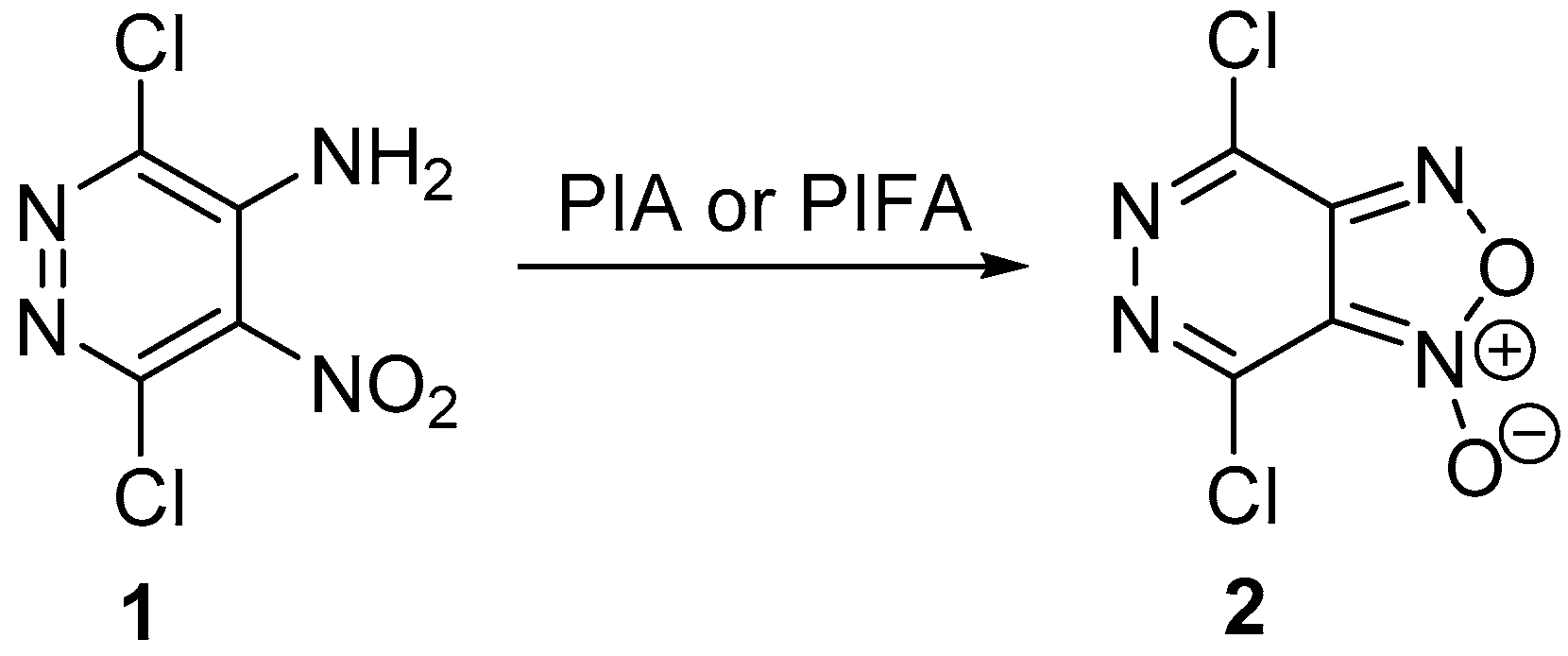4,7-Dichloro[1,2,5]oxadiazolo[3,4-d]pyridazine 1-oxide
Abstract
:1. Introduction
2. Results and Discussion
3. Experimental Section
3.1. General Information
3.2. Synthesis of 4,7-dichloro[1,2,5]oxadiazolo[3,4-d]pyridazine 1-oxide 2
Supplementary Materials
Acknowledgments
Conflicts of Interest
References
- Wu, Y.; Zhu, W. Organic sensitizers from D–π–A to D–A–π–A: effect of the internal electron-withdrawing units on molecular absorption, energy levels and photovoltaic performances. Chem. Soc. Rev. 2013, 42, 2039–2058. [Google Scholar] [CrossRef] [PubMed]
- Zhang, X.; Grätzel, M.; Hua, J. Donor design and modification strategies of metal-free sensitizers for highly-efficient n-type dye-sensitized solar cells. Front. Optoelectron. 2016, 9, 3–35. [Google Scholar] [CrossRef]
- Knyazeva, E.A.; Rakitin, O.A. Influence of structural factors on the photovoltaic properties of dye-sensitized solar cells. Russ. Chem. Rev. 2016, 85, 1146–1183. [Google Scholar] [CrossRef]
- Konstantinova, L.S.; Knyazeva, E.A.; Rakitin, O.A. Recent Developments in the Synthesis and Applications of 1,2,5-Thia- and Selenadiazoles. A Review. Org. Prep. Proc. Int. 2014, 46, 475–544. [Google Scholar] [CrossRef]
- Parker, T.C.; Patel, D.G.; Moudgil, K.; Barlow, S.; Risko, C.; Brédas, J.-L.; Reynolds, J.R.; Marder, S.R. Heteroannulated acceptors based on benzothiadiazole. Mater. Horiz. 2015, 2, 22–36. [Google Scholar] [CrossRef]
- Knyazeva, E.A.; Rakitin, O.A. 4,7-Dibromo-substituted 2,1,3-benzothia(selena, oxa)diazoles and [1,2,5]thia(selena)diazolo[3,4-c]pyridine as building blocks in solar cells components (microreview). Chem. Heterocycl. Comp. 2017, 53, 855–857. [Google Scholar] [CrossRef]
- Marn, J.; Stanovnik, B.; Tishler, M. Pyridazines. XI. Reactions of 1,2,5-thiadiazolo[3,4-d]pyridazines. Croatica Chem. Acta 1971, 43, 101–105. [Google Scholar]
- Makhova, N.N.; Rakitin, O.A. Furoxans fused with heterocycles as promising donors and precursors for nitric oxide donors (microreview). Chem. Heterocycl. Comp. 2017, 53, 849–851. [Google Scholar] [CrossRef]
- Chmovzh, T.N.; Konstantinova, L.S.; Knyazeva, E.A.; Struchkova, M.I.; Rakitin, O.A. A short and safe method for the synthesis of [1,2,5]oxadiazolo[3,4-c]pyridine. Chem. Heterocycl. Comp. 2015, 51, 203–204. [Google Scholar] [CrossRef]
- Tahri, A.; Jonkers, T.H.M.; Raboisson, P.J.-M.B.; Demin, S.D. Quinoxalines and dihydroquinoxalins as respiratory syncytial virus antiviral agents. WO2014/114776, 2014. [Google Scholar]

| Entry | Solvent | Reagent | Temperature, °C | Time, h | Yield, % | |
|---|---|---|---|---|---|---|
| 2 | 1 | |||||
| 1 | benzene | PIDA | 80 | 1 | 45 | 30 |
| 2 | benzene | PIDA | 80 | 2 | 65 | 10 |
| 3 | benzene | PIDA | 80 | 3 | 50 | 5 |
| 4 | toluene | PIDA | 110 | 2 | 10 | 20 |
| 5 | toluene | PIDA | 80 | 2 | 55 | 8 |
| 6 | acetone | PIDA | 56 | 2 | 15 | 25 |
| 7 | benzene | PIFA | 80 | 2 | 5 | 70 |
© 2018 by the authors. Licensee MDPI, Basel, Switzerland. This article is an open access article distributed under the terms and conditions of the Creative Commons Attribution (CC BY) license (http://creativecommons.org/licenses/by/4.0/).
Share and Cite
Chmovzh, T.; Knyazeva, E.; Popov, V.; Rakitin, O. 4,7-Dichloro[1,2,5]oxadiazolo[3,4-d]pyridazine 1-oxide. Molbank 2018, 2018, M982. https://doi.org/10.3390/M982
Chmovzh T, Knyazeva E, Popov V, Rakitin O. 4,7-Dichloro[1,2,5]oxadiazolo[3,4-d]pyridazine 1-oxide. Molbank. 2018; 2018(1):M982. https://doi.org/10.3390/M982
Chicago/Turabian StyleChmovzh, Timofey, Ekaterina Knyazeva, Vadim Popov, and Oleg Rakitin. 2018. "4,7-Dichloro[1,2,5]oxadiazolo[3,4-d]pyridazine 1-oxide" Molbank 2018, no. 1: M982. https://doi.org/10.3390/M982







